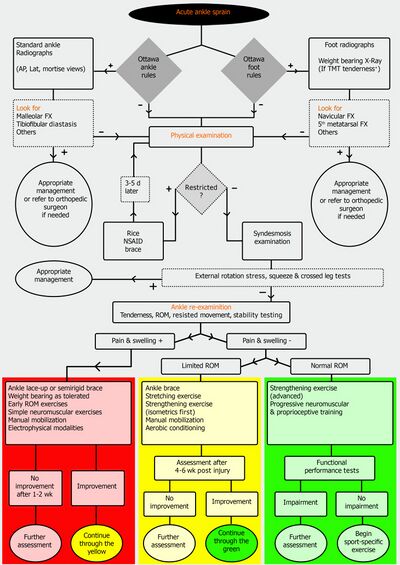Management of Ankle Sprains
Introduction[edit | edit source]
Ankle sprains are considered one of the most frequent traumatic type of injury. Yeung et al, 1994, in an epidemiological study of unilateral ankle sprains, reported that the dominant leg is 2.4 times more vulnerable to sprain than the non-dominant one.[1][2]A conservative treatment is the common approach to ankle injury. The prognosis is generally good, but there is a number of factors influencing the full recovery.[3]These factors, when early identified, can change the treatment protocol to more aggressive approach.[3]
Clinically Relevant Anatomy[edit | edit source]
Lateral Ankle Sprain[edit | edit source]
The literature suggests that 85% of the ankle sprains involves lateral ligaments. [4]The anterior talofibular ligament (ATFL) of the lateral ankle ligament complex is the most frequently damaged when lateral ankle sprain occurs. Their anatomical location and the mechanism of sprain injury mean that the calcaneo-fibular (CFL) and posterior talofibular ligaments (PTFL) are less likely to sustain damaging loads.
Medial Ankle Sprain[edit | edit source]
On the medial side the strong, deltoid ligament complex [posterior tibiotalar (PTTL), tibiocalcaneal (TCL), tibionavicular (TNL) and anterior tibiotalar ligaments (ATTL)] is injured with forceful "pronation and rotation movements of the hindfoot". [5]
Syndesmotic Ankle Sprain[edit | edit source]
The stabilising ligaments of the distal tibio-fibular syndesmosis are the anterior-inferior, posterior-inferior, and transverse tibio-fibular ligaments, the interosseous membrane and ligament, and the inferior transverse ligament. A syndesmotic ankle sprain occurs with combined external rotation of the leg and dorsiflexion of the ankle.
Mechanism of Injury[edit | edit source]
Predisposing Factors[edit | edit source]
Predisposing factors are the risk factors for lateral ankle sprains and they are divided into two categories:intrinsic and extrinsic.[3]
Lateral ankle sprains usually occur during a rapid shift of body center of mass over the landing or weight-bearing foot. The ankle rolls outward, whilst the foot turns inward causing the lateral ligament to stretch and tear. When a ligament tears or is overstretched its previous elasticity and resilience rarely returns. Some researchers have described situations where return to play is allowed too early, compromising sufficient ligamentous repair.[6]
Reports have proposed that the greater the level of plantar flexion the higher the likelihood of sprain[7]
Yeung et al, 1994, in an epidemiological study of unilateral ankle sprains, reported that the dominant leg is 2.4 times more vulnerable to sprain than the non-dominant one.[1][2]
A less common mechanism of injury involves forceful eversion movement at the ankle injuring the strong deltoid ligament.
Classification Grading Systems[edit | edit source]
Clinical Presentation[edit | edit source]
add text here relating to the clinical presentation of the condition
Diagnostic Procedures[edit | edit source]
add text here relating to diagnostic tests for the condition
Outcome Measures[edit | edit source]
add links to outcome measures here (see Outcome Measures Database)
Management[edit | edit source]
Acute Phase[edit | edit source]
Subacute Phase[edit | edit source]
Chronic Phase[edit | edit source]
add text here relating to management approaches to the condition
Resources
[edit | edit source]
add appropriate resources here
References[edit | edit source]
- ↑ 1.0 1.1 Yeung MS, Chan KM, So CH, Yuan WY. An epidemiological survey on ankle sprain. Br J Sports Med. 1994 Jun;28(2):112-6.
- ↑ 2.0 2.1 Roos KG, Kerr ZY, Mauntel TC, Djoko A, Dompier TP, Wikstrom EA. The Epidemiology of Lateral Ligament Complex Ankle Sprains in National Collegiate Athletic Association Sports. Am J Sports Med. 2017 Jan;45(1):201-209.
- ↑ 3.0 3.1 3.2 Ferreira JN, Vide J, Mendes D, Protásio J, Viegas R, Sousa MR. Prognostic factors in ankle sprains: a review. EFORT Open Rev. 2020 Jun 1;5(6):334-338.
- ↑ Halabchi F, Hassabi M. Acute ankle sprain in athletes: Clinical aspects and algorithmic approach. World J Orthop. 2020 Dec 18;11(12):534-558.
- ↑ Beynnon BD, Murphy DF, Alosa DM. Predictive Factors for Lateral Ankle Sprains: A Literature Review. J Athl Train. 2002 Dec;37(4):376-380.
- ↑ Hubbard TJ, Hicks-Little CA. Ankle ligament healing after an acute ankle sprain: an evidence-based approach. J Athl Train. 2008 Sep-Oct;43(5):523-9.
- ↑ Wright IC, Neptune RR, van den Bogert AJ, Nigg BM. The influence of foot positioning on ankle sprains. J Biomech. 2000 May;33(5):513-9.







